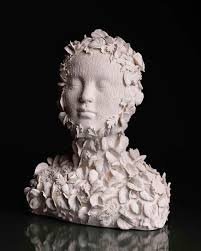Changing climate, changing practice
Invocation
Blessing the boat
By Robin Coste Lewis
Excerpted
Untitled
Anonymous
Clay
Prehistoric
Cow
Bone
Detail
Of a
Balsarium
Glass Moss
Fragment
Untitled Gelatin
Silver Print
On Paper On
Stucco On Canvas
On Concrete
curated by AC Panella, Ph.D. and Emma Logan
In Robin Coste Lewis’ book of poetry, Voyage of the Sable Venus: and Other Poems, Coste Lewis beautifully catalogs the representations of black women in and as Western art objects. Her poem illuminates the connections between humans-resources-material-connection. Our identities are shaped by the context and material around us. As we face the global climate crisis, the resources we want become more scarce, and our identities are threatened. We must change our practices as artists and consumers of art to maintain not just our planet but ourselves.
In conversation, Nikki Green, a ceramicist, said that ceramics are a type of archive of touch. The artists here work with ceramics and sculpture. This is done with the intent to highlight the visceral and material nature of the topic at hand: how do we change our practices with a changing planet?
The following artists work with materials and topics and integrate science into their art practices. In doing so, they challenge us to see the ongoing connection between humans, their identities, and the natural world.
Morel Doucet
Morel Doucet is an arts educator and multidisciplinary artist. Who describes his work as “within the vocabulary of indigenous art and my dreams, I create whimsical forms resulting in a diary of self-mythology. These exchanges allude to a larger conversation about sea-level rise, environmental pollution, and the displacement between descendants of the African diaspora, and their physical environments.” In the works highlighted here, we can feel the layered impact and connection between the ocean as freedom and oppression.
Black Maiden, In Veil of Lavender and Lilac.
Medium: Slip-cast porcelain ceramics. Dimensions: 15.5” x 12.5” x 8”. Year: 2021
Bharti Kher
Bharti Kher is a sculptural artist whose work brings the viewer to connect mystic and material consequences. Her work can be described as “the use of found objects is informed by her own position as an artist located between geographic and social milieus. Her way of working is exploratory: surveying, looking, collecting, and transforming, as she repositions the viewer’s relationship with the object and initiates a dialogue between metaphysical and material pursuits.”
The piece “A consummate joy and a Sisyphean Task” reminds us that in changing our practices, as they relate to climate change, we are rethinking and reusing. This is an iterative and repetitive task. The desire to improve and change is not merely practical, it is aesthetic and mystic.
Catherine Sarah Young
Catherine Sarah Young is a multi-diasporic artist who has lived in ten countries; she uses her background in molecular biology, fine art, and interaction design to create interdisciplinary and experimental artworks on the environment. She cultivates an artscience practice by using scientific experimentation and molecular transformations in her art-making and often relates these to issues of planetary and environmental importance.
The following pieces highlight the ways that science and art can merge to create an artistic and sensory experience of our changing planet.
We end with the following piece, The Weighing of the Heart, casts the ashes of the catastrophic Australian bushfires of 2019-2020. The inclusion of this work is particularly resonant for those of us from California who have been impacted by wildfires. The evidence of the burning world is all around and we must lead with our hearts to make greater changes.
Acionna
Media: Ceramics (cone 06 oxidation), cast, and altered
hand forms. Dimensions: 26 in X 23 in X 20 in. Year: 2012
Bloom. Media: Ceramics. Year: 2013
The Ephemeral Marvels Perfume Store (T.E.M.P.S., or “time” in French) is a futuristic perfume line of things we could lose because of climate change. The first collection included scents that may well disappear as we know it because of global warming and consequential sea level rise, superstorms, and decreased biodiversity, such as the scent of coasts, forests, several crops, etc. Succeeding collections have been made depending on the city the artist was in. The artist creates these perfumes using chemical distillation and standard perfumery techniques. During exhibitions, visitors are allowed to smell the perfumes. We ask you to think about what are some of the sensory experiences that you might lose due to climate change? How would you capture that loss?









